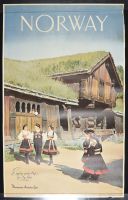Norway
One sheet
vintage travel poster for Norway
, specifically promoting tourism to a traditional rural setting.
Poster Details
Subject: The poster depicts a traditional Norwegian farmstead featuring buildings with characteristic grass roofs. People are shown in the foreground wearing bunads, which are traditional Norwegian folk costumes.
Location Depicted: The scene specifically shows the 16th-century Storehouse from Ose in the Setesdal valley, which is part of the Norwegian Museum of Cultural History (Norsk Folkemuseum) at Bygdøy, Oslo.
Purpose: The poster was issued by the Norway Travel Association and Norwegian State Railways to promote Norway as a summer destination. A version was also used by the Norwegian America Line.
Era: The poster is from around 1961.
The Norwegian Bunad
The clothing worn by the people in the image, the bunad, is a significant symbol of Norwegian cultural identity and regional heritage.
Symbolism: Each region or even specific village in Norway has its own distinct bunad with unique colors, fabrics, and embroidery patterns. This allows the wearer to display their geographic origins or ancestry.
Occasions: Today, bunads are typically worn for major celebrations such as weddings, baptisms, confirmations, and especially on Norwegian Constitution Day (May 17th).
Authenticity: The design of some bunads dates back centuries, while others were reconstructed or inspired by traditional wear in the 19th and 20th centuries as a way to express national identity during Norway's path to independence from Sweden
vintage travel poster for Norway
, specifically promoting tourism to a traditional rural setting.
Poster Details
Subject: The poster depicts a traditional Norwegian farmstead featuring buildings with characteristic grass roofs. People are shown in the foreground wearing bunads, which are traditional Norwegian folk costumes.
Location Depicted: The scene specifically shows the 16th-century Storehouse from Ose in the Setesdal valley, which is part of the Norwegian Museum of Cultural History (Norsk Folkemuseum) at Bygdøy, Oslo.
Purpose: The poster was issued by the Norway Travel Association and Norwegian State Railways to promote Norway as a summer destination. A version was also used by the Norwegian America Line.
Era: The poster is from around 1961.
The Norwegian Bunad
The clothing worn by the people in the image, the bunad, is a significant symbol of Norwegian cultural identity and regional heritage.
Symbolism: Each region or even specific village in Norway has its own distinct bunad with unique colors, fabrics, and embroidery patterns. This allows the wearer to display their geographic origins or ancestry.
Occasions: Today, bunads are typically worn for major celebrations such as weddings, baptisms, confirmations, and especially on Norwegian Constitution Day (May 17th).
Authenticity: The design of some bunads dates back centuries, while others were reconstructed or inspired by traditional wear in the 19th and 20th centuries as a way to express national identity during Norway's path to independence from Sweden
Disclaimer
The object and/or subject of this report is private property. This page is for informational purposes only. Unless clearly stated otherwise, all conservation and restoration has been performed by Poster Mountain (PM) or Los Angeles Paper Group (LAPG)I) PM-LAPG has not knowingly withheld any significant information from its evaluation report and to the best of its knowledge all statements and evaluations in this report are true and correct.
II) PM-LAPG stated in the Evaluation Report its own personal, unbiased and professional analysis, opinions and conclusions, which are subject to the assumptions and limited conditions in this evaluation report as set forth hereinabove.
III) PM-LAPG has no present or prospective interests in the property which is the subject matter of this report and it has no present or prospective personal interests or bias with respect to the participants in this matter.
IV) PM-LAPG and its employment and/or compensation for performing this evaluation or any future anticipated evaluation was not conditioned on any agreement or understanding, written or otherwise, that it would report (or present analysis in support) as predetermined specific authenticity, a predetermined evaluation that favors the cause of any party or the attainment of any specific result or occurrence of a specific subsequent event, such as value or marketability.
V) PM-LAPG prepared all opinions and conclusions about the subject property that were set forth in this Evaluation Report. If it has relied on significant evaluation assistance from any individual or individuals in the performance of this evaluation or the appropriation of this evaluation report, PM-LAPG has named such individuals and disclosed the specific task performed in this evaluation report. PM-LAPG certifies that any individual so named is qualified to the same extent as PM to perform the task. PM-LAPG has not authorized anyone to make a change to any item in this evaluation report, therefore, any change made to this evaluation is unauthorized and PM-LAPG will not take responsibility for it.
VI) The Client may not disclose or distribute this Evaluation Report to any potential purchasers of the subject property without first obtaining PM-LAPG's prior written consent. This consent must be obtained before this evaluation report may be disclosed or distributed to any other party, including, but not limited to, the public through advertising, public relations, news, sales, or other media.

